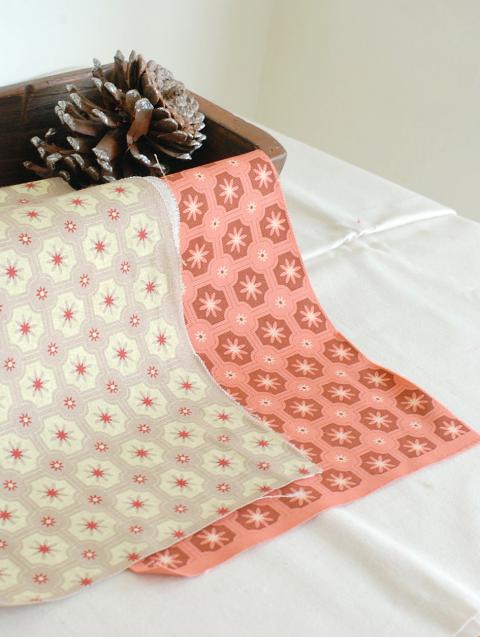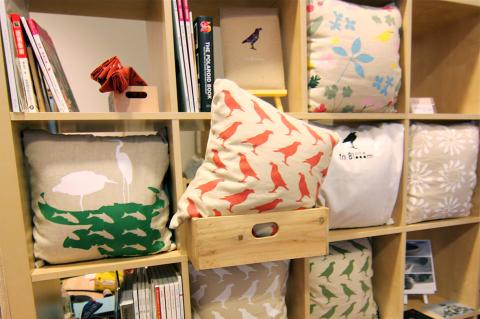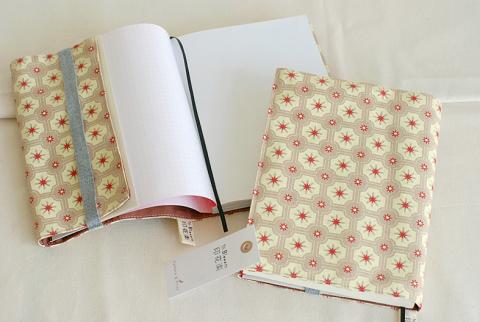In Blooom’s (印花樂) textiles combine clean, bold lines inspired by Scandinavian brands like Marimekko with motifs taken from Taiwan’s ecology and daily life.
The fledgling company opened its first store last month in a Japanese colonial era building across the street from Yongle Market (永樂市場) on Dihua Street (迪化街). The newly remodeled structure in the historic heart of Taiwan’s fabric industry is home to Art Yard (小藝埕), a cultural center that is scheduled to open this spring.
In Blooom’s first series of designs feature silhouettes of this country’s native flora and fauna, including the Taiwanese crested myna (台灣八哥), an increasingly rare species. Other prints include images of egrets, ghost crabs and water buffaloes.

Photo Courtesy of In Blooom
The group’s second line has tessellated patterns based on the colorful ceramic tiles that were a common feature in Taiwanese homes built during the 1960s and 1970s, but are gradually disappearing as older residences are remodeled or demolished. In Blooom project planner Chiu Chung-yu (邱瓊玉) says she and her two co-designers were attracted to the tiles because they evoke feelings of nostalgia in many Taiwanese people. The first prints in the series were based on flooring in Chiu’s Changhua County childhood home.
“Our goal for our brand is to celebrate our heritage by focusing on the collective memories and impressions that Taiwanese people have,” Chiu says.
In Blooom was founded in 2008 after its three designers graduated from university: Chiu and Hana Tsai (蔡玟卉) from Taipei National University of the Arts (國立臺北藝術大學) and Ama Shen (沈奕妤) from National Taiwan Normal University (國立台灣師範大學). The trio became friends during art classes in high school.

Photo: Catherine Shu, Taipei Times
“When we were in college, we always talked about how there really is no difference between fine art and design,” Chiu says. “The two are split into separate departments by schools, but we think they should be combined, because designers figure out how to bring art into daily life.”
After graduating, the friends were awarded a grant from a government program to help young designers launch their own companies. The three originally thought about opening a wedding photography studio, but start-up costs were too high. They decided to pursue textile design instead to take advantage of their experience with printmaking and silk-screening.
In Blooom’s canvas totes, reusable shopping bags, cushions and slip-on book covers are printed by the design team in its art studio at Taipei National University of the Arts’ hilltop campus in Kuandu (關渡), Beitou District (北投區), and sewn by seamstresses in Bali District (八里區), New Taipei City.

Photo Courtesy of In Blooom
Chiu says the team initially hoped to find a retail space near Zhongshan MRT Station (中山捷運站), where many independent designers have opened combination studio-stores, but the rent was too high.
“The space we wanted would have been NT$70,000 a month. To afford that, we would have had to start selling fine jewelry instead,” Chiu says. While looking for a storefront, the In Blooom team was contacted by Jou Yi-cheng (周奕成), the founder of Sedai Group (世代文化創業群), and invited to sell at Art Yard. The In Blooom team now comanages the space.
Once a three-story residence, the building was gutted after a fire in 1998. Rebuilt by the government in 2009, it will eventually house a coffee shop and gallery. In Blooom’s store shares the ground floor with Hakka Blue (台客藍), which creates handmade pottery inspired by the indigo fabric used in traditional Hakka clothing.
The In Blooom team eventually plans to offer a selection of imported textiles alongside its own designs to attract designers and hobbyists who shop for fabric at the century-old Yongle Market.
“If we want to create prints unique to Taiwan, then we have to understand our consumers and how to work our textiles into their daily lives,” Chiu says.

In the March 9 edition of the Taipei Times a piece by Ninon Godefroy ran with the headine “The quiet, gentle rhythm of Taiwan.” It started with the line “Taiwan is a small, humble place. There is no Eiffel Tower, no pyramids — no singular attraction that draws the world’s attention.” I laughed out loud at that. This was out of no disrespect for the author or the piece, which made some interesting analogies and good points about how both Din Tai Fung’s and Taiwan Semiconductor Manufacturing Co’s (TSMC, 台積電) meticulous attention to detail and quality are not quite up to

April 21 to April 27 Hsieh Er’s (謝娥) political fortunes were rising fast after she got out of jail and joined the Chinese Nationalist Party (KMT) in December 1945. Not only did she hold key positions in various committees, she was elected the only woman on the Taipei City Council and headed to Nanjing in 1946 as the sole Taiwanese female representative to the National Constituent Assembly. With the support of first lady Soong May-ling (宋美齡), she started the Taipei Women’s Association and Taiwan Provincial Women’s Association, where she

Chinese Nationalist Party (KMT) Chairman Eric Chu (朱立倫) hatched a bold plan to charge forward and seize the initiative when he held a protest in front of the Taipei City Prosecutors’ Office. Though risky, because illegal, its success would help tackle at least six problems facing both himself and the KMT. What he did not see coming was Taipei Mayor Chiang Wan-an (將萬安) tripping him up out of the gate. In spite of Chu being the most consequential and successful KMT chairman since the early 2010s — arguably saving the party from financial ruin and restoring its electoral viability —

It is one of the more remarkable facts of Taiwan history that it was never occupied or claimed by any of the numerous kingdoms of southern China — Han or otherwise — that lay just across the water from it. None of their brilliant ministers ever discovered that Taiwan was a “core interest” of the state whose annexation was “inevitable.” As Paul Kua notes in an excellent monograph laying out how the Portuguese gave Taiwan the name “Formosa,” the first Europeans to express an interest in occupying Taiwan were the Spanish. Tonio Andrade in his seminal work, How Taiwan Became Chinese,